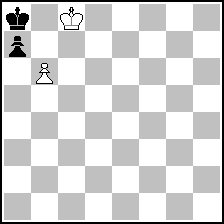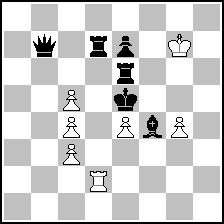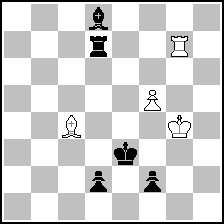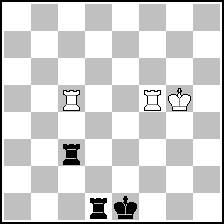
Website founded by
Milan Velimirović
in 2006
17:33 UTC


| |
MatPlus.Net  Forum Forum  Misc Misc  A most unusual Babson A most unusual Babson |
| |
|
|
|
|
You can only view this page!
| | | (1) Posted by Sarah Hornecker [Monday, Jun 22, 2009 16:25] | A most unusual Babson
 (= 2+2 ) (= 2+2 )
Zalmen Kornin
chessproblem.net; 19th June 2009 [1]
Replace both Pawns for pieces of their same colour, for a correct:
(a) #2 - Mate in Two
(b) h#1(*) - Helpmate in One, With Set-Play
(c) A Drawn Position, Without Check
(d) An Illegal Position
[1] http://chessproblem.net/viewtopic.php?f=30&p=712#p712
| | | (2) Posted by Michael McDowell [Monday, Jun 22, 2009 16:59] |
As the Babsontask involves promotions this certainly is unusual.
| | | (3) Posted by Frank Richter [Monday, Jun 22, 2009 17:15] |
a) should be "in exact 2", then why not replace the pawns by rooks with mate in 1?
| | | (4) Posted by Axel Gilbert [Monday, Jun 22, 2009 19:31] |
I had at first glance overlooked that the pieces needn't be of the same nature.
So, this is somewhat the spirit of a babson-task.
a) I think the key word here is "correct". With rooks (or with WQ against BR), this is a "correct" #1 but a cooked #2.
Same for b), we have other possibilities (WQ against BR or BB) but with no unique solution, what should be precised, for a helpmate can carry several solutions and be "correct" anyway !
c) the mention "without check" is alas unavoidable (otherwise WN against BB is correct)
d) allright, funny
| | | (5) Posted by Sarah Hornecker [Monday, Jun 22, 2009 19:51] |
Zalmen explained:
QUOTE
The form is of a Replacer (also a new word?!) , kind of a construction exercise - the quartet is original - note that "correct" here means just - a solution without cooks, or duals, that 'drawn position' is one in which a draw would be proclaimed (no tricks like 50-moves-rule etc)
| | | (6) Posted by Zalmen Kornin [Wednesday, Jun 24, 2009 13:32]; edited by Zalmen Kornin [09-06-25] |
I'm glad to realize that the quartet achieved quickly the goal of being clearly understood... Only I would not call it a B., not even a "task" at all - they're just 4 related puzzles each one showing a double 'transformation' - I can not take 4 different problems and call it a whole - the effect may be similar, but the merit of construction is far away from a real composing tour-de-force
A Replacer... also similar to a "promotion", but without need of reaching the last file...
(a) Exactly what is asked for - but of course not mate in less or more then 2
(b) When more than one solution is required, also this shall appear in the enunciate - but (*) for set-play - a single set mate to a single real mate - is very important here, otherwise a black Q could mate in 'b7' after B or Q b6 to d8
Thanks for the comments
| | | (7) Posted by Frank Richter [Friday, Jun 26, 2009 08:25] |
Thinking about the title I would say, this problem is far more a Forsberg than a Babson.
Nevertheless a very funny discovery.
| | | (8) Posted by Nikola Predrag [Friday, Jun 26, 2009 13:16]; edited by Nikola Predrag [09-06-26] |
The spirit of Fosberg twins: the solver looks for the solution with pieces which are appointed by the author. It is irrelevant what happens if some other pieces were chosen.
Here, the pieces have to be chosen by the solver and the author gives the position and very precise stipulation which allows only the solution with pairs of w+b pieces of the same type. That resembles the spirit of Babson.
| | | (9) Posted by Zalmen Kornin [Thursday, Jul 2, 2009 15:36] |
Solutions and some notes newly added http://www.chessproblem.net/viewtopic.php?f=30&t=319
| | | (10) Posted by Kevin Begley [Friday, Jul 3, 2009 04:12]; edited by Kevin Begley [09-07-03] |
In my opinion, the "spirit of a Babson" is promotions with Matched AUW (though cyclic AUW is a logical extension).
The point being, I see no promotions here -- I see an "unpromoted Babson (or unpromoted matched AUW) by replacement."
Pawns replaced (and note that the pawns are not entirely necessary here, though they are a welcome way to ground the problem to a famous position, with a rich history) is a far stretch from pawns promoting in the course of a solution.
This is no closer to Forsberg twinning, since Forsberg twins do not require a matching pair.
Plus, here, the twins are left for the solver to discover (which makes this something entirely new).
It would be more impressive, frankly, if the stipulations were more closely related.
The divergent twins are a drawback, but nevertheless, on the whole, this is a very impressive discovery...
Finally, there is a further wrinkle here...
Assume that U-AUW = unpromoted AUW (Queen, Rook, Bishop, Knight).
Then, here we have a matched U-AUW (or a U-Babson, if you prefer) by replacement.
However, whereas AUW = complete set of promotions, this is not a complete set of replacements!
Kings and Pawns, too, could be replaced...
To achieve the likes of a complete AUW, using a replacement mechanism, I think, requires the full set of 6 replacements.
Thus, a complete matched replacement may require 6 sets of replacements: KK, QQ, RR, BB, SS, PP.
To achieve this would require a remarkable immaginiation, plenty of hard work, and considerable luck.
My guess is, this is the real equivalent to a "Babson-task" by replacement...
Only time will tell...
I expect we will see many more U-AUWs, super-U-AUWs (maybe Pawns & Kings too!?), Matched-U-AUWs (or U-Babsons), and Cyclic U-AUWs (or cyclic u-Babsons?), by a replacement mechanism.
| | | (11) Posted by Sarah Hornecker [Friday, Jul 3, 2009 07:08] |
Let's call it the Kornin theme then!
| | | (12) Posted by Kevin Begley [Friday, Jul 3, 2009 13:55]; edited by Kevin Begley [09-07-03] |
Siegfried says: Let's call it the Kornin theme then!
OK, what is the definition of "Kornin's theme" ?
A set of 4 matched replacements?
Must they also show an unpromoted-AUW?
Need there be pawns replaced?
Can the replacements occur on squares which are not the same?
Frankly, I don't know that I consider his problem a good "achievement" of what you would call Kornin's theme...
The plain truth is, the twinning is all over the place, and some of the stipulations are badly compromised.
e.g., all the stipulations are preceded by the term "correct" -- and the impact on the stipulations is far from clear:
1) can I have duals?
2) can the key be checking, capturing, flight-taking?
3) please define "correct." (has such a stipulation ever been used before?).
Taken on the whole, the problem is nice; and, the idea shown (what you call Kornin's theme) is profoundly good.
OK, Joseph Babson did not achieve his theme in a directmate.
He was the first to achieve it in some form (selfmate in 3).
So, Kornin's Theme has some merit...
But, consider this: Babson was technically the first to achieve Kornin's Theme, without need of any twins!
The point being, if we take Yarosh's #4 Babson, play the first 3 half-moves, change the promoted units to lumps (or pawns) and then say "replace these lumps with pieces, for #3 (with black to play)" we have Kornin's Theme. Same goes for Babson's selfmate 3 -- but, we get a selfmate in 2 (with black to play).
Now, consider how much easier it is to "replace" than to promote in the course of a solution.
1) promotion is limited to 8 squares white + 8 squares black (replacements can be anywhere!).
2) promotion must be a valid move in the time of solution (no defense against replacements, no alternative moves are possible!).
This problem does not compare to a Babson-Task.
It is so much easier to achieve the "Kornin Theme," and this needn't have been done with any twinning (nevermind the wildly divergent twinning, and the unorthodox stipulation used).
I maintain that this new problem should be judged on its entirety (creativity, originality, the deliberate relation to a problem with a rich history, etc), and perhaps a disservice is done by making comparisons to a Babson-task.
Furthermore, I expect we will see the following demonstrated (and very soon):
Drop 1 white unit + 1 black unit (perhaps where some lumps are, perhaps anywhere) to achieve one well-known stipulation, with 5 solutions (no twins!), showing a full set of matched replacements: QQ, RR, BB, SS, PP.
In essence, a matched Forsberg is what this would be (let us not forget that Forsberg showed Q, R, B, S, and yes, Pawn too!!).
Anything less than 5 sets, it seems to me, should be considered incomplete.
And, that is my argument against calling this "Kornin's Theme."
Essentially, we are on the trail here of a matched Forsberg (not a matched AUW).
To achieve this, there must be a full 5 sets of replacements.
Of course, the author could chose from over a thousand aims (already shown), to achieve a set of pawn replacements, but these would all be anticipated (what cruel irony, that achieving a set of Pawn replacements is now extremely difficult!).
Even if the author were to pull it off, however, this is not a real Forsberg.
In a Forsberg, you replace units to achieve a single stipulation (no twins, or no Forsberg).
| | | (13) Posted by Sarah Hornecker [Friday, Jul 3, 2009 14:22] |
QUOTE
OK, what is the definition of "Kornin's theme" ?
Replacement of a placeholder piece by pawns, knights, bishops, rooks, queens (and maybe kings).
QUOTE
Must they also show an unpromoted-AUW?
Need there be pawns replaced?
Can the replacements occur on squares which are not the same?
Yes
QUOTE
Furthermore, I expect we will see the following demonstrated (and very soon):
Drop 1 white unit + 1 black unit (perhaps where some lumps are, perhaps anywhere) to achieve one well-known stipulation, with 5 solutions (no twins!), showing a full set of matched replacements: QQ, RR, BB, SS, PP.
Yes, that would be exactly the theme!
QUOTE
Even if the author were to pull it off, however, this is not a real Forsberg.
In a Forsberg, you replace units to achieve a single stipulation (no twins, or no Forsberg).
That'd be a Forsberg-Babson then.
| | | (14) Posted by Kevin Begley [Saturday, Jul 4, 2009 01:36] |
Siegfried says: That would be a "Forsberg-Babson..."
Not quite.
What I described was a matched-Forsberg.
Forsberg = full replacement (all 5 units: Q, R, B, S, and P), to obtain a single aim.
Matched Forsberg = matched full replacement (all 5 units: QQ, RR, BB, SS, and PP), to obtain a single aim.
You can't call this Kornin's Theme, because Kornin has not shown it.
Joseph Babson was not the first to think of a matched-AUW, but he was the first to show it (that's why it is called a "Babson").
Kornin has shown 4 -- not the full 5 -- sets of matched replacements (QQ, RR, BB, SS, but not PP).
Furthermore, this was achieved with a number of aims (and all of them prefixed by the term "correct," which is improper, if not incorrect).
This is no matched Forsberg.
I don't know what your mean by "Forsberg-Babson," but it certainly sounds absurd.
It would be like asking for an AUW from an orthodox Aristocratic Miniature (each are exclusive to one another).
Babson = matched promotions to the full set of 4 possible (QQ, RR, BB, SS).
Forsberg = no promotions, but replacements to the full set of 5 possible (Q, R, B, S, P).
My best guess at what a Forsberg-Babson is, quite frankly, would be a Forsberg twin, where in the pawn replacement solution, a Babson is achieved... and just to figure that out, unfortunately, has sapped all my imagination for the day. :(
As I have stated, this problem, which is incorrectly billed as "a most unusual Babson" (which it is not, as there are no promotions), is on the trail of a "matched Forsberg" (see my definition).
But, it falls short of attaining this, in two (maybe three) key places.
1) It employs a number of stipulation changes (a true Forsberg is only twinned upon the replacements themselves -- ONE AIM).
2) It does not achieve the full replacement (the 5th element of the set, PP replacement, is missing).
3) One could also argue that the stipulations, which must be prefixed by the loaded term, "CORRECT," may not be fully "correct."
I do consider this a very good problem, when taken on the whole.
However, this is not a Babson, not a Forsberg, not a Forsberg-Babson, not a Babson-Forsberg, and it is not a matched-Forsberg.
Nevertheless, the problem does hint at something much greater than has been achieved here.
A matched-Forsberg is the obvious theme this problem hints at...
And, beyond that, who knows... perhaps a cyclic-Forsberg.
I expect we will see many matched- and cyclic-Forsbergs (and very soon!)...
But, with some rush to be the first to show this, prepare to hold your noses (I fully expect cheap, ugly, and fast).
| | | (15) Posted by Zalmen Kornin [Saturday, Jul 4, 2009 14:47]; edited by Zalmen Kornin [09-07-05] |
Maybe I should recapitulate what I stated myself from start:
* a quartet (...) kind of a construction exercise;
** (...) A neologism, and perhaps a good motto, could be "Allumväter" - as it's a complete set of double transformations, similar to promotions, the Babson idea is also suggested... But the quartet is far away from a 'TASK', where a whole should work under a single enunciate ! ('far away' = 'far below', believe to be quite clear here...)
THEME - No, I never claimed for a new theme here - in a third forum I referred to this just as "ZK's Winter Puzzle (or call it 'Summer Puzzle' if You are in the Northern Hemisphere)" - presenting a link to that article showing also some of the earliest Sower Sows etc
CORRECT - again: *** "correct" here means just - a solution without cooks, or duals (hardly need for developing this point)
TWIN - definition found online "Twin - two or more problems which are slight variations on each other, composed by the same person. The variation is usually brought about by adding, removing or moving a piece in the initial setup." Quite a serious breach in this entry! -Why TWINS should be (sic) "composed by the same person"(??!!) - Anyway, no "modification in the setup etc", yes...
Anyway, Kevin still raise an interesting point above: "the pawns are not entirely necessary here, though they are a welcome way to ground the problem to a famous position, with a rich history) is a far stretch from pawns promoting in the course of a solution." Interesting! - The image of a Pawn arriving to the end of the board, and becoming, say, decrepit, and being replaced by one of four pieces is so strong that hardly someone would remark that feature...
| | | (16) Posted by Zalmen Kornin [Sunday, Jul 5, 2009 13:41]; edited by Zalmen Kornin [09-07-05] |
ps: as nobody yet answered my previous post, I removed the later part - that could appear rather irreverent. I could never assert about some -sic- "new piece, or new condition" etc
Just a puzzle, and just Chess... and maybe also - a supplement to a known position - the best definition is still Construction Exercise, I believe. Thanks again for the comments. ZK
| | | (17) Posted by Kevin Begley [Tuesday, Jul 7, 2009 01:25] |
>The image of a Pawn arriving to the end of the board, and becoming, say, decrepit, and being replaced by one of four pieces is so strong that hardly someone would remark that feature...
Difficult to make out exactly what is meant by this wording (perhaps a bad translation?)...
I assume the author thinks the pawns being "replaced" in his problem leaves some strong image (almost a pseudo-promotion).
But, the pawns do not "arrive" anywhere -- certainly not to the board's end (where they become, umm, decrepit)...
They were placed in the diagram, to fill space, when no such place holder was required...
Because the placement does show a clear relation to a well known problem, this can be excused (and forgiven), as artistic license.
It managed to fool a few into thinking psedu-Babson, I suppose (perhaps even the author), but this illusion doesn't hold up.
There is no pseudo-Babson here.
And, usage of the term "correct" in the stipulation remains a severe drawback (which begs for correction).
The author is mistaken to suggest that this is a suitable term to attach to any stipulation.
With such scattered twins, I doubt there is much value correcting the individual stipulations here...
Plus, why settle for the illusion of a false-Babson (by replacement), when a complete matched-Forsberg is waiting to be discovered?
On the whole, I commend the author for this very imaginative and artistic effort.
Except that, until the stipulation is corrected, I do not regard the problem as sound.
I am not prepared to accept the term "correct," without a clear definition, and some examples.
And even then, this kind of cook-prevention is grotesque (beyond even the use of dummies, and holes).
| | | (18) Posted by Arpad Rusz [Tuesday, Jul 7, 2009 10:10] |
I remember a helpmate in two which had a white and a black knight in the initial position. The two twins were obtained by replacing the 2 knights with 2 bishops, or by 2 rooks. Who knows, maybe it is possible to have the queens too...
| | | (19) Posted by Joost de Heer [Tuesday, Jul 7, 2009 11:04] |
Manne Persson
Mat 1983
 (= 7+6 ) (= 7+6 )
h#2
(b)  d2, d2,  d7 d7
(c)  d2, d2,  d7 d7
(d)  d2, d2,  d7 d7
Fadil Abdurahmanovic
Feenschach 1962, 3rd prize
 (= 4+5 ) (= 4+5 )
h#2
(b)  g7, g7,  d7 d7
(c)  g7, g7,  d7 d7
(d)  g7, g7,  d7 d7
Araz Almamedov
idee & form 1996-1997, 1st HM
 (= 3+4 ) (= 3+4 )
h#2
(b)  c4, c4,  e7, e7,  b3, b3,  b4 b4
(c)  c4, c4,  e7, e7,  b3, b3,  b4 b4
(d)  c4, c4,  e7, e7,  b3, b3,  b4 b4
| | | (20) Posted by Nikola Predrag [Tuesday, Jul 7, 2009 13:01] |
3x(2+2)
Marko Klasinc
Gavrilovic MT 1974
3. Preis
 (= 3+3 ) (= 3+3 )
h#2
b) wLc5, wLf5, sLc3, sLe1
c) wSc5, wSf5, sSc3, sSe1
| |
No more posts |
MatPlus.Net  Forum Forum  Misc Misc  A most unusual Babson A most unusual Babson |
|
|
|
 ISC 2024
ISC 2024 Forum
Forum  Misc
Misc  A most unusual Babson
A most unusual Babson 


